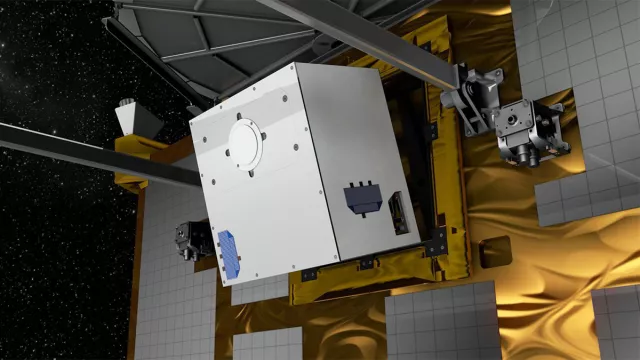The Japanese Hayabusa2 spacecraft and its MASCOT lander are on a mission to analyse the composition of asteroid 1999 JU3 (Ryugu) and return samples from it to Earth. Developed by the German space agency DLR and CNES, MASCOT was released onto the asteroid’s surface in 2018.
Key information
| Mission | Analysis of asteroid Ryugu’s mineral composition, temperature and magnetic characteristics, sample collection and return |
|---|---|
| Domain | Science |
| Launch date | 3 December 2014 |
| Partners | JAXA, DLR |
| Where | Cruise phase to asteroid from 2014 to 2018, landing of MASCOT in 2018 and sample return in December 2020, followed by mission extension with asteroid flyby in 2026 and rendezvous with a near-Earth object (NEO) in 2031 |
| Lifetime | Six years for Hayabusa2 + extension |
| Status | In operation, mission extended |
Key figures
- 600 kg: spacecraft mass
- 6 instruments aboard spacecraft
- 10 kg: mass of MASCOT lander
- 4 instruments aboard MASCOT lander
Key milestones
- July 2031: Flyby of asteroid 1998 KY26
- June 2028: Third Earth gravity assist
- December 2027: Second Earth gravity assist
- July 2026: Flyby of asteroid 2001 CC21
- December 2020: JAXA extends Hayabusa2 mission to 2031
- 6 December 2020: Earth sample return capsule recovered
- 5 December 2020: Earth sample return capsule released
- November 2019: Hayabusa2 begins return to Earth
- 8 October 2019: MINERVA-II 2 sets down on Ryugu
- 2 October 2019: MINERVA-II 2 rover in orbit around Ryugu
- 21 September 2018: Japanese MINERVA-II 1A and 1B rovers set down on Ryugu
- 3 October 2018: MASCOT lands on Ryugu
- 14 August 2018: Landing sites selected for rovers and landers
- 27 June 2018: Arrival in orbit around asteroid Ryugu
- 3 December 2015: First Earth gravity assist
- 2015: Discussions begin to select landing site
- 3 December 2014: MASCOT launched with Hayabusa2 by H-IIA
- 16 June 2014: DLR delivers MASCOT flight model to JAXA
- 12 March 2012: MASCOT selected for Hayabusa2 mission
- 2009: MASCOT project kicks off
- 2006: Hayabusa2 project kicks off
Project in brief
In December 2014, Japan’s Hayabusa2 spacecraft departed Earth carrying MASCOT (Mobile Asteroid Surface Scout), a lander developed by the German space agency DLR in partnership with CNES. Its mission was to collect samples from 1999 JU3 (Ryugu), an Earth-crossing asteroid some 920 metres across. Hayabusa2 reached its destination in 2018, then in October 2018 released the MASCOT lander onto the asteroid’s surface. Using its four instruments, among them the MicrOmega infrared microscope developed by the IAS space astrophysics institute in Orsay with CNES oversight, MASCOT analysed the asteroid’s soil at two different sites. Hayabusa2 collected samples of the soil that were returned to Earth in December 2020.
DLR was responsible for developing the MASCOT lander and ground segment, and in charge of planning and conducting lander operations. CNES supplied the MicrOmega instrument, antennas and electrical power system. Hayabusa2 was launched by JAXA, the Japanese space agency.
CNES’s role
The MASCOT lander was developed by CNES in partnership with DLR.
For the MASCOT project, CNES was responsible for:
- Supplying the power subsystem:
- Primary batteries
- PCDU (Power Control and Distribution Unit)
- Supplying the antennas
- Supplying the MicrOmega instrument
- Lander mission analysis
- MASCOT-Hayabusa2 link budget, integrating performance of the antennas and CCOM unit supplied by JAXA
CNES also provided support to DLR for integrating MASCOT deliverables at system level, planning and executing MicrOmega operations, and for the power and communications subsystem.
Contacts
Project Leader
Aurélie Moussi
E-mail: aurelie.moussi at cnes.fr
Solar System Planets and Small Bodies subject matter expert
Francis Rocard
E-mail: francis.rocard at cnes.fr


